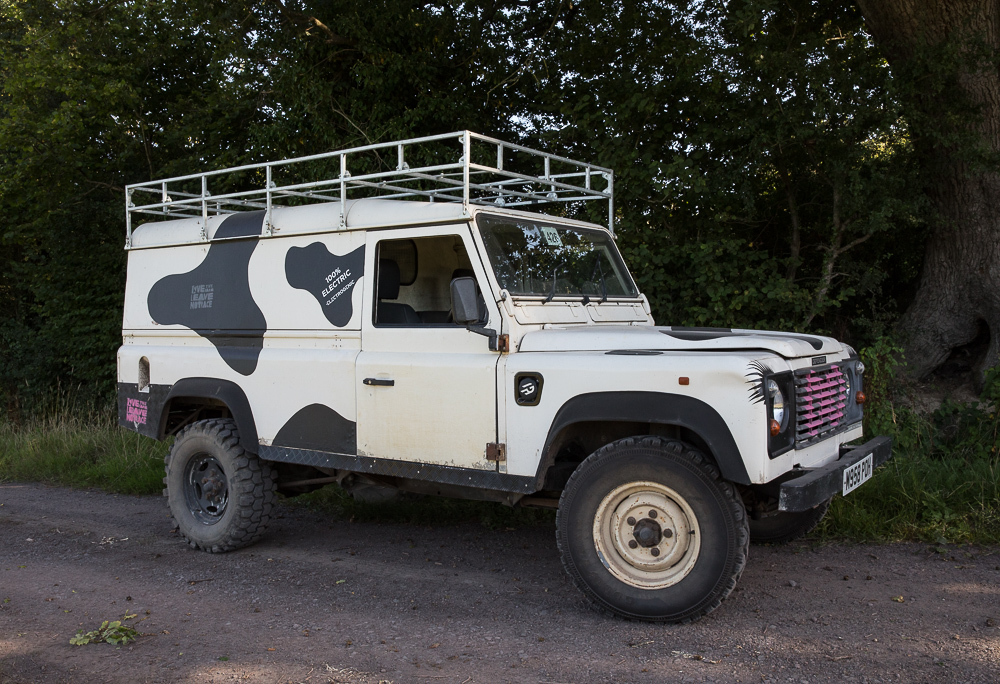
Defender Conversion Kit
Register your interest HERE
The Defender picked up where the Series III left off, initially called the Land Rover 90 and the Land Rover 110, representing the two main wheelbase variants. The Defender name itself did not come until 1990. By this time, the Land Rover portfolio included the Range Rover and the newly launched Discovery. A new name was fitting for a vehicle previously only referred to by its wheelbase length and Series number.
The Defender is the ubiquitous British offroad vehicle and is used by farmers and landowners throughout the British Isles and beyond. In 2020 Electrogenic got together with Worthy Farm (of Glastonbury fame) and Cardiff University, supported by Innovate UK, to create a low-cost conversion “kit” to enable the conversion of a working Land Rover Defender to all-electric drive. Worthy Farm has hosted test vehicles since November 2020 and now has four of them in use daily, doing all the normal jobs come snow, rain or shine. Cardiff University have carried out modelling to enable the vehicle’s performance at Worthy Farm to be projected on to other settings.
The drop-in conversion kit has been built down to a price. We have achieved our objective of a pay-back of 4 years or less for average farm use. This means your converted agricultural Defender will do everything you want it to do on the farm, quietly and with spirit, but it is not built for motorway cruising or long road trips – if you want a conversion like this, look at our high-voltage conversions. The drop-in kit is designed to be fitted by by partner businesses around the world. It is simple but performs well, including taking trailers into situations where the original vehicle would have stalled or burnt out the clutch. It includes a 53kWh battery pack, which is more than enough for average farm use – simply plug it in to charge every night.
“They’re good little Land Rovers. We use them on a daily basis and they do everything we want them to do. Financially they’re great: each one saves about £6,000 a year in fuel plus there’s no road tax and less maintenance. There’s no worrying about driving to a petrol station – just unplug and off you go – and on cold frosty mornings, there’s a little switch and you have instant heat.” – Farm Manager
The electric conversion specification – we convert or supply a kit
The conversion is a simple one, with a low-voltage Hyper9 electric motor replacing the diesel engine, and driving the 4WD system through the original gearbox. Electric vacuum pump, power steering and heating are added, together with LED lighting. The 53kWh battery pack simply lifts into the engine bay in the form of two 135kg boxes that plug together. Range is about 100 miles or so on road, and further off-road – though of course it depends on hilliness, trailer towing, etc. The air-cooled charge point is located in what was the carburettor air intake. The charging system is air-cooled and as standard will not deal with rivers deeper than the driver’s footwell.
Electronic “engine braking” for controlled descent of off-road hills is provided by means of a 3-position rocker switch, though other input devices can be substituted. This is an important feature for towing!
| Petrol Engine | Electric Motor | |
| Power: | 50kW | 90kW |
| Torque: | 158Nm @ 2,700rpm | 235Nm @ 0rpm |
| Transmission | Gearbox | Original gearbox |
| Battery: | 52kWh | |
| Fuel: | Diesel | Electricity |
| Cost Per Mile: | 21p | 3.8p |
| CO2 Per Mile: | 0.39kg | 0kg |
Overall it is a great addition to the farm:
- It improves sustainability – reducing carbon emissions, and recycling instead of replacing a useful farm vehicle
- It saves money: it has a 4-year payback and the expected life of the batteries is 200,000 miles, and 50 years for the motor
- It excels at short trips – quiet and efficient when a diesel engine would be cold and inefficient
- The heater comes on instantly – very popular with the farm workers on cold mornings
- No trips to the petrol station – very popular with farm managers!
- It makes towing easy – performance is not compromised
- It’s quiet and nippy – e.g. it’s great for nipping round behind the cows when you need to move them







